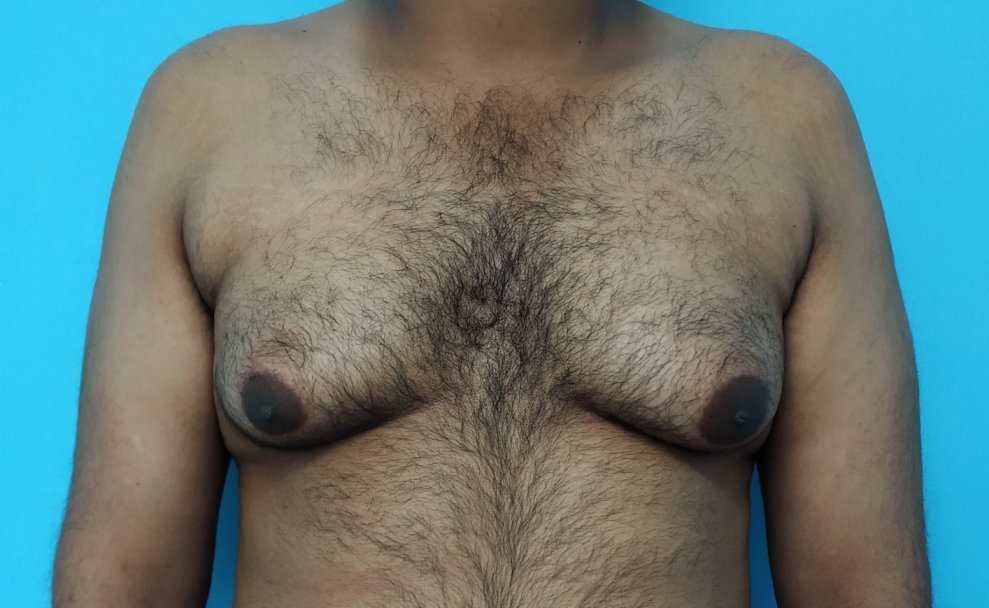|
Gynecomastia is excess breast tissue in men. In a subset of individuals with gynecomastia, there can be redundant or excess skin. The excess skin affects the outcomes following a gynecomastia corrective surgery. It can mean a longer duration to achieve an acceptable outcome. In some cases, we may do additional surgery to take care of excess skin.
How does skin redundancy present in gynecomastia? Redundant skin is usually apparent with a clinical examination. The breast tissue tends to sag in such individuals. The breasts appear deflated. There can be visible folds on the lower part, and lateral areas of the chest. The presence of ptosis or sagging gives an aged appearance to the chest. Who are the individuals prone to get skin redundancy associated with gynecomastia? The risk factors associated with excess skin in gynecomastia include:
What are the treatment strategies that can be adopted in case of skin excess? hereAmong individuals with excess body weight, it is always recommended to lose weight before undergoing a surgical correction. Optimizing the body weight before surgery has certain advantages. It is easier to assess the extent of excess skin before surgery. This makes the surgical outcome more predictable. In some cases, we may opt to undertake skin reduction during the time of gynecomastia correction. With weight loss, patients can benefit from the skin recoil beforehand. In an individual, with excess skin, gynecomastia correction can be done in two different ways. It can be done either with skin excision or without skin excess. Both strategies lead to different outcomes. When the correction is carried out without a skin excision there may be a postoperative course with an increase in the deflated appearance. This usually improves with time due to the skin recoil. It may take many months before the full extent of skin recoil is appreciated. We usually advise our patients to wait as much as 8 months before deciding on an additional surgery to remove the skin excess. Many patients are usually satisfied with the skin recoil and choose not to have any skin excision procedures. This has the advantage of an initial simpler procedure with shorter scars. Skin excisional procedures are associated with longer and more visible scars. The second strategy would include gynecomastia correction carried out with simultaneous skin excision. The pattern of the excision can vary depending on the extent of skin excess. Patients with more excess tend to have a greater amount of skin removed. With this technique, the excess skin is addressed in a single procedure. However, it carries the disadvantage of longer scars. In our practice, this approach is less commonly used. We tend to choose individuals with severe excess for this approach. What are the steps that can be taken by an individual to address excess skin? The excess skin is usually seen to accompany increased body weight. Individuals should try to maintain their weight close to ideal. This is usually achieved with the help of dietary modifications such as diet and exercise. Weight training helps recruit the excess skin and contributes to reduced sagging over the lower part of the chest. Weight training and accompanying muscle hypertrophy also bring along aesthetic benefits. Excess skin is seen in some individuals presenting with gynecomastia. This is more commonly seen in those with excess body weight. The skin excess can be tackled with surgery in a staged or simultaneous way. Both strategies have their advantages and disadvantages. A treatment plan is chosen based on individual preferences and extent of excess skin. Individuals with skin excess can help improve this condition with appropriate dietary modifications and exercise. Learn more about gynecomastia here. In case of any doubts, we would be glad to hear from you.
Comments are closed.
|
AuthorI like to keep it simple. CategoriesArchives
June 2024
Categories |
- Home
-
Cosmetic
- Fat grafting
- Swellings and moles
- Scar revision
- Leukoderma (Melanocyte transfer)
- Hair transplant
- Facial rejuvenation procedures
- Nose job (Rhinoplasty)
- Cleft lip nose correction
- Ear (Otoplasty)
- Lip reduction
- Breast augmentation
- Breast reduction
- Tuberous breasts
- Axillary breasts
- Gynecomastia
- Liposuction
- Brachioplasty (Arm contouring)
- Abdominoplasty (Tummy tuck)
- Female genital rejuvenation
-
Reconstructive
- Contact
- Blog
- Home
-
Cosmetic
- Fat grafting
- Swellings and moles
- Scar revision
- Leukoderma (Melanocyte transfer)
- Hair transplant
- Facial rejuvenation procedures
- Nose job (Rhinoplasty)
- Cleft lip nose correction
- Ear (Otoplasty)
- Lip reduction
- Breast augmentation
- Breast reduction
- Tuberous breasts
- Axillary breasts
- Gynecomastia
- Liposuction
- Brachioplasty (Arm contouring)
- Abdominoplasty (Tummy tuck)
- Female genital rejuvenation
-
Reconstructive
- Contact
- Blog
You can leave us a comment using the contact form below.
We shall get back to you at the earliest.
We shall get back to you at the earliest.
Links
- Face procedures | Rhinoplasty, Otoplasty, Lip reduction, Fat grafting
- Body procedures | Gynecomastia , Breast reduction, Abdominoplasty, Brachioplasty, Liposuction
- Skin procedures | Scar revision, Moles, Leukoderma surgery
Let's be friends !
Follow us at Facebook and Twitter.
Follow us at Facebook and Twitter.
© 2024 Amicus Clinic (Plastic Surgery Centre, Trivandrum). All rights reserved.

 RSS Feed
RSS Feed



